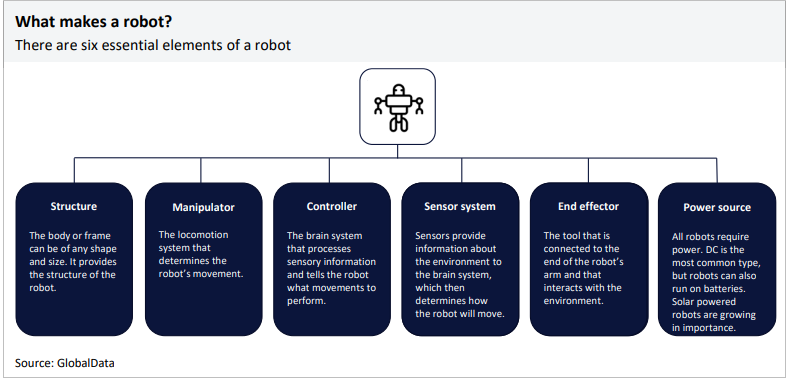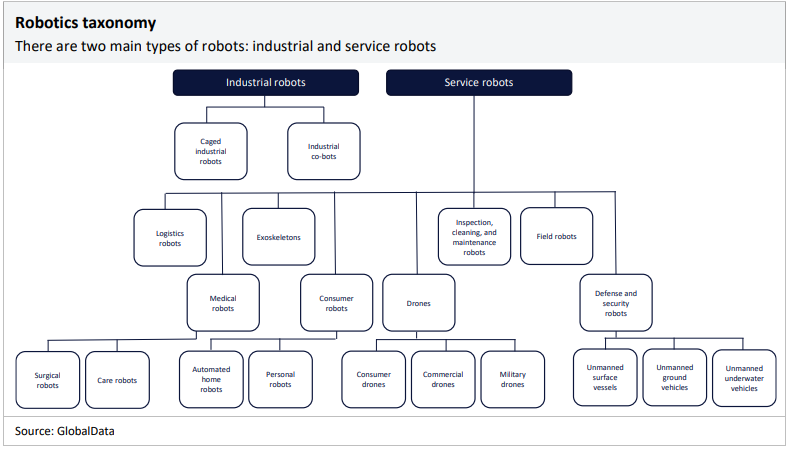What is a robot?
Joseph Engelberger, an American engineer and pioneer in the field of industrial robotics, reportedly said, “I can't define a robot, but I know one when I see one.”
Art and popular culture tend to represent robots as mechanical versions of humans. Even though today’s robots take various shapes, the components that make a robot have similarities with the functions performed by the different parts of the human body.
After all, one of robotics’ primary functions is to replace the work of humans when that work is repetitive, hazardous, or requires a level of precision better achieved by a machine.
Defining a robot
GlobalData defines a robot as a machine capable of carrying out a complex series of actions (typically programmed by a computer) automatically and repeatedly. Robotics is the branch of technology that deals with the design, construction, operation, and application of robots.

From automata to modern robotics
Robots, as we know them, are a 20th -century creation. However, the idea of automata or mechanical devices built to replace human labor on physical tasks is much older. Examples go as far back as ancient Egypt, Greece, and the Roman Empire.
The first known case is from Egypt in around 3,000 BC when human figurines were built into water clocks to automatically strike the hour bells.
In 400 BC, Greek philosopher and mathematician Archytas of Tarentum invented a wooden pigeon that could fly. Archytas is also the inventor of the pulley and the screw. Robotics’ roots are intertwined with the origins of mechanics and automation.
Greek texts on automation were translated into Arabic in the medieval era, giving rise to Arabic mechanical engineering. Arab engineers developed new types of gears and valves that led to the emergence of automata more complex than what existed in ancient Egypt.
The next stage of progress in automation happened in Europe during the Renaissance when artists created robot dancers and musicians. In 1738, Jacques de Vaucanson, a French artist and inventor, built a flute-playing robot.
At this point in Europe, robots were mainly used for entertainment, but automata soon found their way into the world of labor and were a crucial factor in the first Industrial Revolution. Mill machinery, water pumps, and, of course, the steam engine all involved a degree of automation.
While automata have existed for millennia, the word “robot” first appeared in 1921 in Karel Capek’s science-fiction play R.U.R. (Rossumovi Univerzální Roboti or Rossum's Universal Robots). “Robot” comes from the Czech word “robota” which means “forced labor.”
The play describes a world where human-like machines made of synthetic organic matter replace humans in the workplace. The robots become displeased with their situation, start a revolution, and kill the entire human race.
Following on from Capek’s pivotal work, literature and cinema have addressed the topic of human replacement, and sometimes destruction, by robots numerous times in the last 100 years, from Blade Runner and Terminator to WALL-E.
Fascination with and suspicion of robots in the 20th century coincided with great leaps forward in the evolution of robotics, coupled with the emergence of modern computing. What distinguishes millennia-old automata from modern robots is intelligence.
Modern robots can perform physical tasks autonomously, as all automata can, but they can also sense the environment in which they operate and make their own decisions.
The first modern robot was built in the 1960s by the Stanford Research Institute (SRI) in the US. Named Shakey by the SRI due to its wobbly movements, it could analyze commands and break them down into basic parts by itself. While other robots would require instruction on each step of a larger task, Shakey could complete all the steps involved in a task after receiving just one multi-step command.
Robot ethics and the socio-economic impact of automation
As robots became more sophisticated and omnipresent, they entered the human subconscious, and robot ethics became an important branch of technology philosophy. Robot ethicists study the integration of robotics in society.
Two decades before Shakey, in 1942, Isaac Asimov established the famous Three Laws of Robotics in the science-fiction short story Runaround. The first law is that a robot shall not harm a human or, by inaction, allow a human to come to harm. The second law is that a robot shall obey any instruction given to it by a human, and the third law is that a robot shall avoid actions or situations that could cause it to come to harm itself.
The three laws have survived the test of time and are often evoked in discussions about the role of robotics in society or even what rules should govern the circulation of autonomous vehicles.
Society’s suspicion of robots does not come only from the sci-fi-promoted myth that machines will one day annihilate humans. Concerns are growing that robots might substantially reduce both human employment opportunities and the quality of employment.
This is not a new concern. In the 19th century, the Luddites destroyed machines used to make textiles for fear that their skills would become obsolete, and that machinery would overtake their craft.
The Industrial Revolution showed that fear of new technologies could be overstated. As machines made some manual tasks obsolete, many new machine-operating and machine-maintenance jobs emerged. However, the concerns of 21st - century Luddites are not unfounded.
A study by Daron Acemoglu and Pascual Restrepo, published in the Journal of Political Economy in 2020, found that a single industrial robot typically replaces six human workers. According to the research, one additional robot per 1,000 workers in the US reduces the employment-to-population ratio by 0.2 percentage points and wages by 0.4%.
As robotics spreads to more industrial and service sectors, one of the most important tasks for policymakers will be to harness the economic benefits of robotics while minimizing the negative social impacts.
Types of robots
Jacques de Vaucanson would probably not recognize that most of today’s robots are related to the flute-playing automaton he built in the 18th century. The same can probably be said about factory workers 100 years later or Egyptians in 3,000 BC And yet, today’s robots exist to fill the same role that automata have occupied for the last 5,000 years.
That is, for entertainment or to replace humans in repetitive or strenuous tasks. Industrial robots fall into the latter category. Service robots include machines built to help humans with work or chores at home and robots designed to entertain.

Industrial and service robots are the two main categories within robotics.
Industrial robots
Industrial robots are typically used in factories to automate parts of the manufacturing process and can be split into two sub-categories.
- Caged industrial robots: Industrial robots that work in a cage to avoid the risk of human injury.
- Co-bots: Robots designed to work alongside humans on specific tasks.
Service robots
Service robots assist humans at work in non-industrial settings or the home. They can be split into eight main subcategories and a myriad of use cases:
- Logistics robots: Autonomous devices capable of transporting goods with limited human assistance, e.g., warehouse robots and delivery robots. In this report, delivery drones are considered commercial drones.
- Medical robots: Robots used in the medical sciences, including surgical robots and personal care robots. There are two sub-types of medical robots:
- Surgical robots: Remote manipulators used in keyhole surgery.
- Care robots: Robots that help care for patients in a hospital, a care home, or a private home by lifting them and providing medicine at the correct time.
Exoskeletons: Wearable mobile machines that allow for limb movement with increased strength and endurance. The main use cases are in healthcare, defense, and manufacturing.
Consumer robots: Robots that are primarily used for household chores or education and entertainment. There are two sub-types of consumer robots:
Automated home robots: Robots that can undertake household chores such as cleaning and mowing the lawn.
Personal robots: Robots that interact with humans and are used for play and entertainment. Typically, voice- or touch-activated or controlled by a mobile device (e.g., a tablet).
- Drones: Unmanned aerial vehicles (UAVs). There are three sub-types of drones:
- Consumer drones: A UAV designed for the mass market.
- Commercial drones: A UAV used for business purposes such as delivery, factory inspection, agricultural spraying, or aerial photography.
- Military drones: A UAV used by the military for reconnaissance or as a weapon delivery system.
Inspection, cleaning, and maintenance robots: Robots used for inspection (e.g., sewer systems), cleaning, and maintenance.
Field robots: Mobile robots that operate in dynamic, unstructured environments. They are mainly used in agriculture.
Defense and security robots: Mobile robots that are used for security, law enforcement, military, and defense purposes. This report considers military drones and exoskeletons in their dedicated categories. There are three subtypes of defense and security robots:
- USVs: Unmanned surface vessels.
- UGVs: Unmanned ground vehicles.
- UUVs: Unmanned underwater vehicles, including remotely operated vehicles (ROVs)
GlobalData, the leading provider of industry intelligence, provided the underlying data, research, and analysis used to produce this article.
GlobalData’s Thematic Intelligence uses proprietary data, research, and analysis to provide a forward-looking perspective on the key themes that will shape the future of the world’s largest industries and the organisations within them.